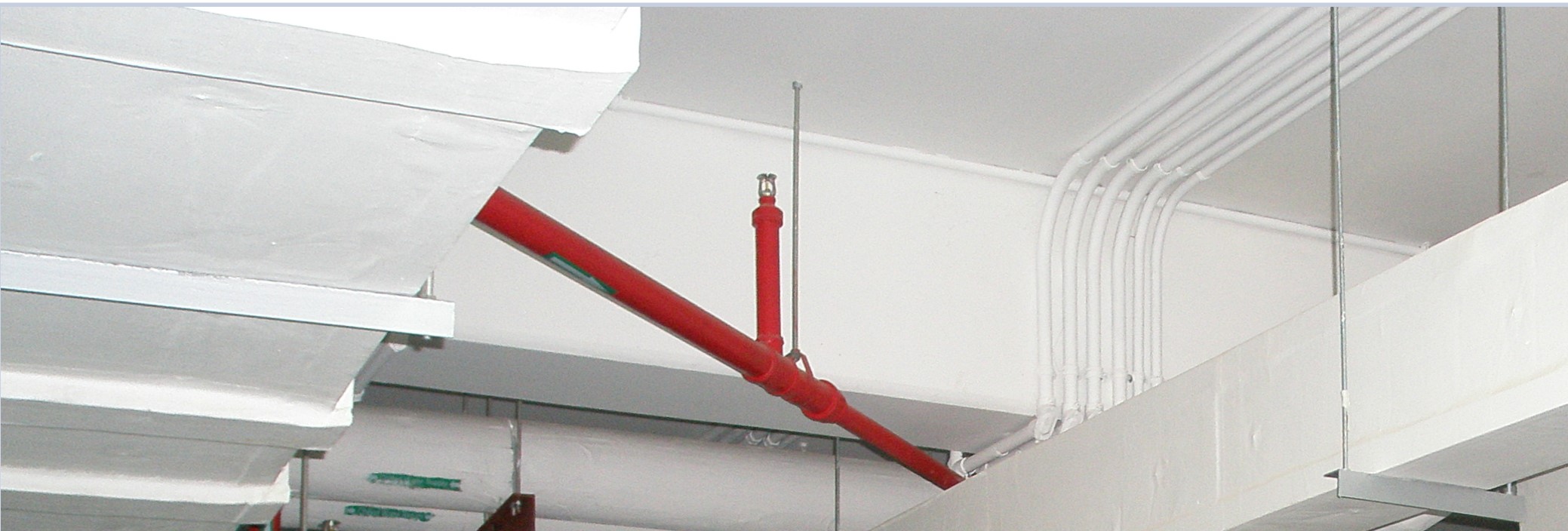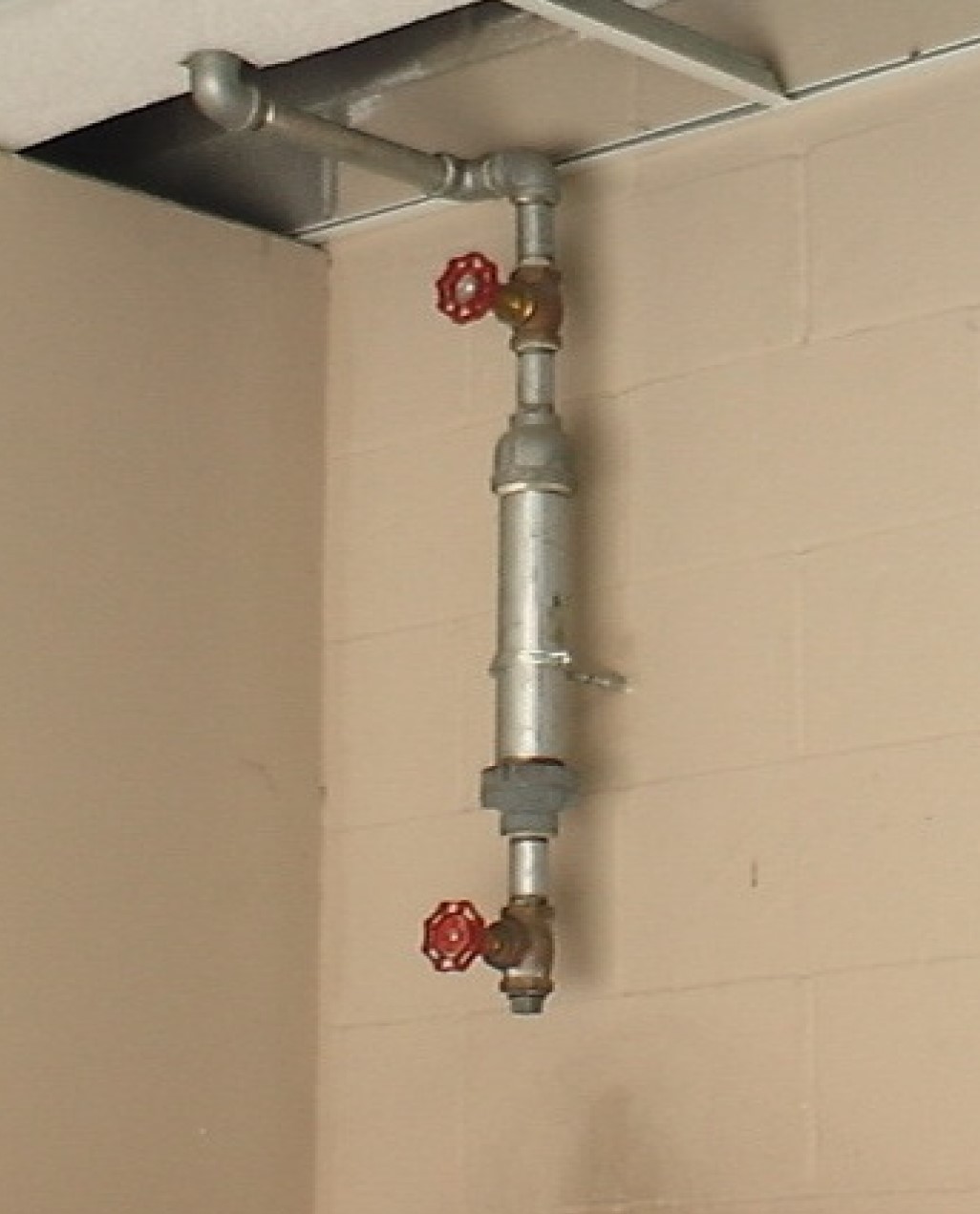
What are Dry Pipe Fire Sprinkler Systems?
Dry pipe sprinkler systems are utilized in areas of the facility where sprinkler protection is required, but is likely to experience freezing conditions. These areas can include: attics, entry vestibules, outside canopies, and similar areas. (If you are unsure if you have dry pipe sprinkler systems, refer to your Annual Sprinkler System Inspection Report.)
Dry pipe sprinkler systems function in a similar manner to normal “wet” type sprinkler systems. Dry systems, however, are pressurized with air instead of water under normal circumstances within the section of piping that is exposed to freezing conditions. In these dry systems, when a fire occurs, a “dry pipe valve” operates and allows water to enter the system, replace the air, and be discharged onto the fire.
Why is Dry Pipe Fire Sprinkler System Winterization needed?
In addition to the periodic inspections, additional attention is required to remove any water in the system that may potentially freeze. This additional water is typically due to condensation and draining of the water within the system. When this trapped water freezes within the sprinkler system, the result is often costly due to damaged pipe and/or property.
To facilitate draining water out of dry sprinkler systems, most of these systems have drains called drum drips (also referred to as “auxiliary drains”, “drip legs” or “condensate drains”). Drum drips typically consist of two 1 inch valves with a short section of two inch pipe between them (see picture). They are installed to collect water that enters the system and provide an easy way for it to be drained.
The drum drips are normally located at the lower portions of the system, or where piping elevation changes may occur. NOTE THAT THERE MAY BE MULTIPLE DRUM DRIPS ON THE SYSTEM AND ALL NEED TO BE DRAINED.
Removing water from a dry system is an essential part of a good maintenance program. Failure to keep the dry system free of water can result in damage and expensive repairs to both the system and building.
A program for monitoring the condition of the system and the operation of the auxiliary drains should be instituted. Auxiliary drains should be operated on a daily basis after a dry sprinkler system operation until several days pass with no discharge of water from the drain valve. Thereafter, it might be possible to decrease the frequency to weekly or longer intervals depending on the volume of water discharged.
Likewise, when preparing for cold weather, the auxiliary drains should be operated daily with the frequency of operation decreasing depending on the discharge of accumulated water. In many cases, the frequency of the operation can decrease significantly if a system stays dry.
A quick-opening device, if installed, should be removed temporarily from service prior to draining low points.
REMEMBER ALL DRUM DRIPS MUST BE DRAINED ROUTINELY DURING FALL AND WINTER MONTHS, EVEN WHEN WATER IS NOT FOUND ON A REGULAR BASIS.
 Step-by-step drum drip draining procedure
Step-by-step drum drip draining procedure
1 Locate all drum drips throughout the property, remembering that there may be multiple drum drips in each area mentioned above.
2 If installed, temporarily remove the quick opening device from service.
3 At each drum drip, close both valves on the drum drip (if not already shut).
4 Remove the plug in the bottom valve, if present, and provide suitable container if needed to capture drained water. (Note: plug may not be present if drum drip drains to exterior location)
5 Open the top valve, slowly, to full open position. Maintain in open position for 10 seconds. (Note: If valves will not operate or are stuck, contact your Telgian Representative for assistance)
***WARNING: NEVER OPEN BOTH TOP AND BOTTOM VALVE AT THE SAME TIME. ACCIDENTAL TRIP OF THE DRY VALVE MAY RESULT***
6 Close the top valve.
7 Open the bottom valve, slowly, and watch for water to discharge. Note: Some drum drips may not allow you to see the discharge point, so allow water to drain for approximately 10 seconds.
8 Close the bottom valve.
9 If water is observed on step 7, repeat steps 5 thru 8 until no additional water drains out.
10 When completely drained, close the bottom valve, slowly open the top valve and replace plug (if applicable) to return the drum drip to service.
11 If installed, restore the quick opening device to service.
Tips: For drum drips with drains that cannot be observed during draining (that is, discharge is located on outside of building wall), a second person may be helpful to watch the drain to see when water stops running. Another alternative is to place a small container under the drain and empty it after step 8 until no water is found in the container. In some areas a container may be useful to prevent water damage to surrounding areas or to prevent spilled water in a traffic area.
NFPA standards call for drum drips
NFPA standards call for drum drips within the buildings to be identified to make it easier on building owners and maintenance staff to properly care for them as needed. This information is excerpted here for your use/benefit, and Telgian highly recommends that these signs and identification be provided to simplify this process in the future.
4.1.7 Valve Location. The location of shutoff valves shall be identified.
4.1.8 Information Sign.
4.1.8.1 A permanently marked metal or rigid plastic information sign shall be placed at the system control riser supplying an antifreeze loop, dry system, pre-action system, or auxiliary system control valve.
4.1.8.2 Each sign shall be secured with a corrosion-resistant wire, chain, or other approved means and shall indicate at least the following information:
(1) Location of the area served by the system
(2) Location of auxiliary drains and low-point drains for dry pipe and pre-action systems
(3) The presence and location of antifreeze or other auxiliary systems
(4) The presence and location(s) of heat tape
Dry Pipe Fire Sprinkler System Winterization Next Steps
If your dry pipe or pre-action systems show signs of being tripped (are filled with water), or your staff discovers excessive amounts of water when performing the drain task, we encourage you to contact Telgian Fire Safety immediately, so we may assist you in remedying the situation before a greater problem occurs.
Since 1985, Telgian Fire Safety has served as a trusted partner to clients around the globe, providing innovative solutions and keeping facilities safe, compliant and on budget. Telgian’s expertise includes testing, inspections and repair of Fire Sprinkler Systems, Fire Alarm Systems, Fire Extinguishers, Kitchen Hood Suppression Systems, Backflow Systems, Emergency/Exit Lights, Special Hazards, Clean Agent Systems and Fire Alarm Monitoring.
We welcome the opportunity to discuss how we can provide testing, inspections and repair services for you. For additional information about Telgian Fire Safety, please click here. To arrange a meeting to discuss your specific needs, please contact us at sales@telgian.com or give us a call at 1.480.753.5444.
 Step-by-step drum drip draining procedure
Step-by-step drum drip draining procedure